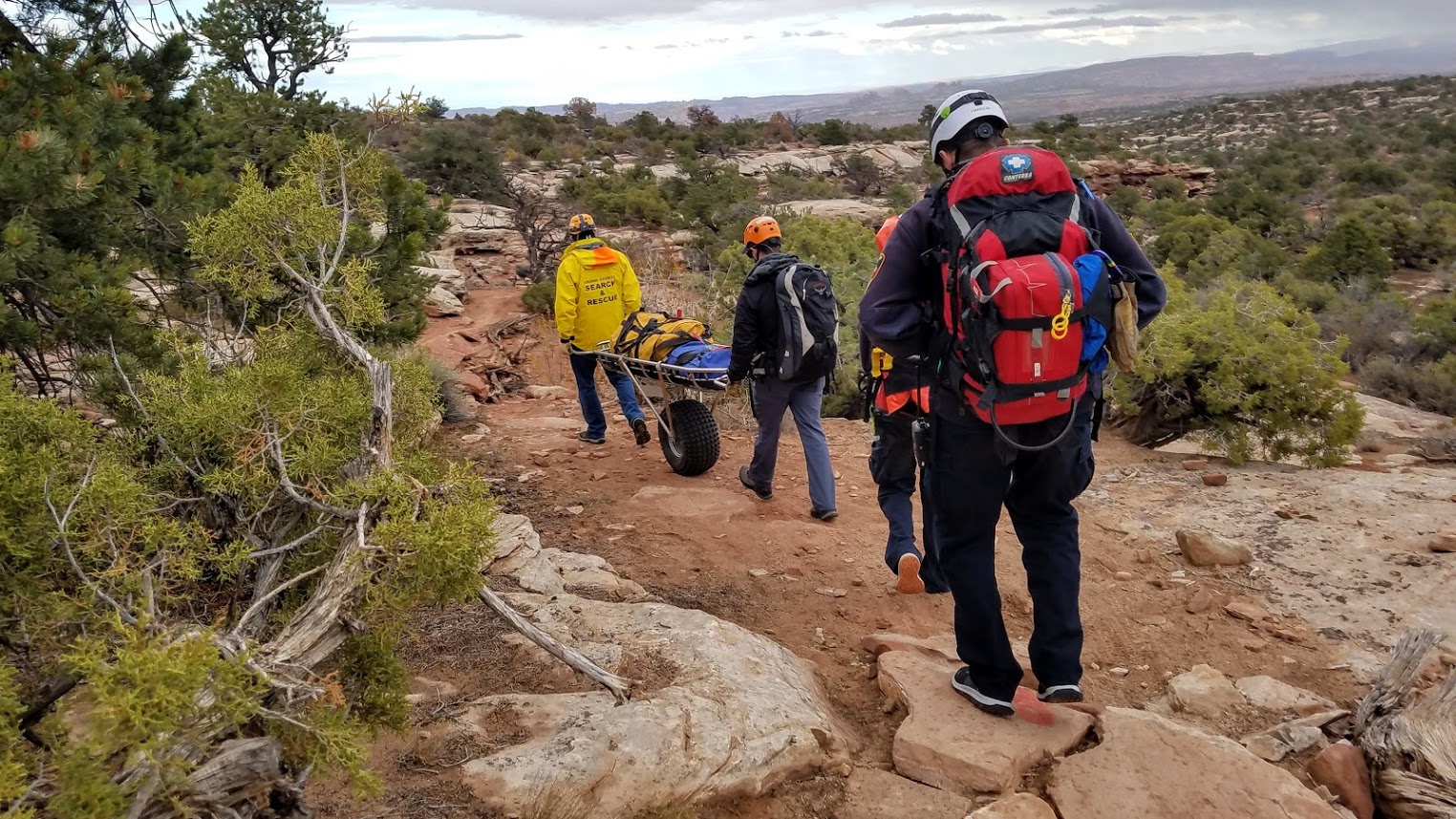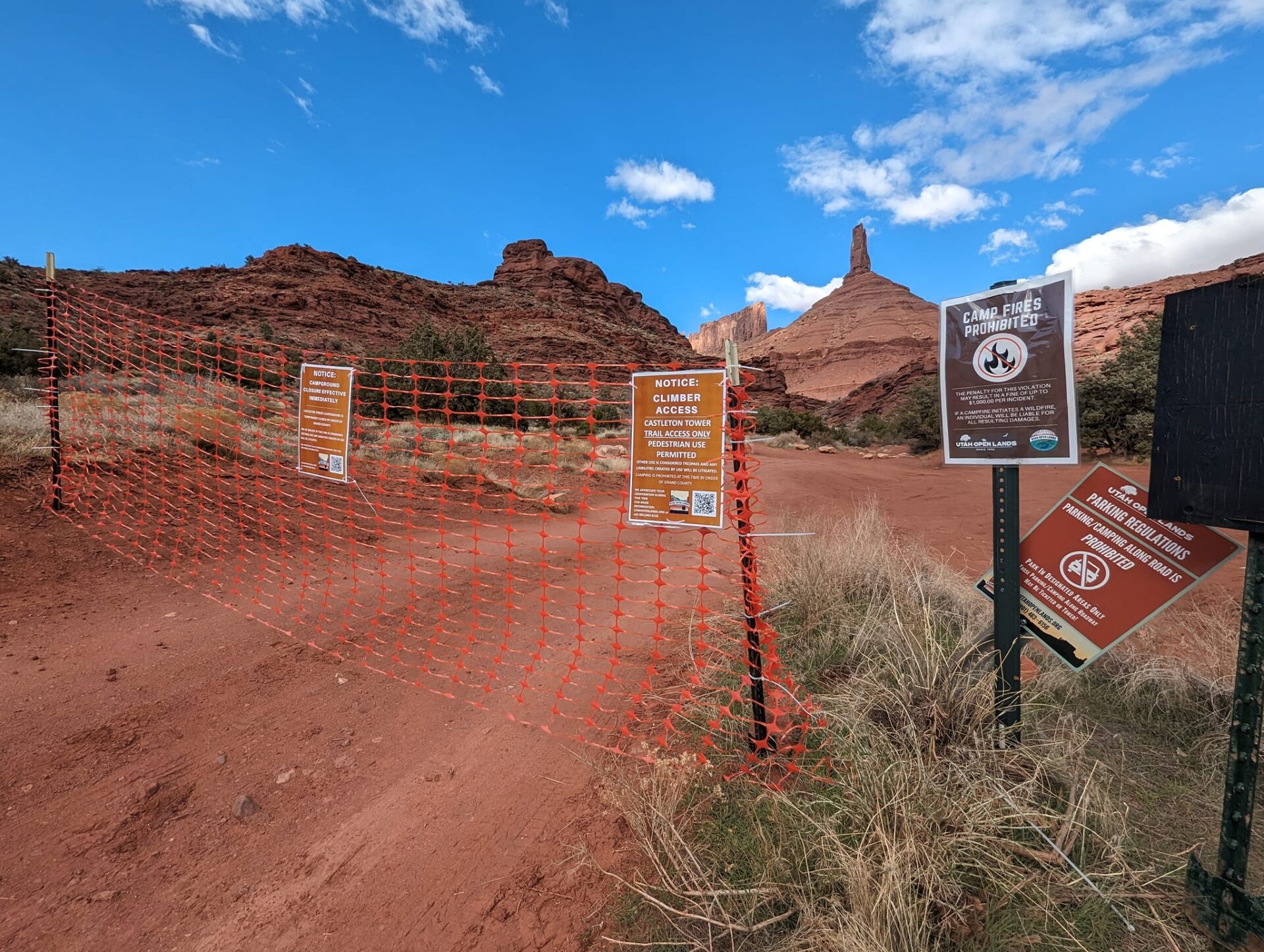Is it any wonder that Grand County Search and Rescue is the most active rescue team in the state of Utah? Each year, thousands of people from around the world recreate in canyon country’s red-rock playground. Lack of preparation can best even the toughest visitor to this expanse of steep ledges, dangerous waterfalls, swift rapids and unforgiving desert temperatures.
There is always, at a minimum, one Grand County Search and Rescue (GCSAR) volunteer on-call for when a critical situation arises. When people need help, they call 911. From there, the Grand County Sheriff’s Office dispatch notifies GCSAR.
“A page goes off, people call in to say ‘I’m responding,’ we grab our gear, load up in search and rescue vehicles, and off we go,” said Nancy May, a GCSAR administrative assistant.
GCSAR has 30 volunteers with extensive training who do “a little bit of everything,” said Jim Webster, GCSAR commander.
“We provide training twice per month in river and high-angle rescue, ATV use, helicopter safety, map and navigation skills,” Webster said.
May compiled a comprehensive report of the data behind every search and rescue call in 2017. Last year, GCSAR responded to 132 incidents. Mountain biking was the most dangerous activity with 45 accidents. Hiking came in second with 22 incidents. There were 16 motorcycle-related accidents and six reports were associated with boating and water activities.
There were eight ATV/UTV incidents reported, a number that has increased, May said.
“We used to see mostly hikers and mountain bikers,” May said. “Eight years ago, more ATV injuries started showing up all around the country.”
On the Colorado Plateau, the sound of buzzing ATV engines has significantly increased over the years.
“People should slow down, wear seatbelts, don’t drive past their abilities,” May said.
The GCSAR data show that more people were injured by ATV/UTVs than by base jumping, an extreme sport that some consider to be more dangerous. And when it comes to leaping from high ledges, GCSAR responded to more calls from people jumping off the waterfall on the left hand of Mill Creek than base jumping off cliffs, with six and five reports, respectively.
Spring and fall months see the most GCSAR action, echoing the height of tourist season. The report for 2018 is not yet complete, but so far, there have been 111 incidents called in to GCSAR.
Then there were 27 people in 2017 who were listed as missing or overdue.
“Overdue just means lost,” May said. “They underestimated the time the hike would take.”
Despite the specific activities listed on the GCSAR report, overdue persons and most other incidents are exacerbated by dehydration.
“Just about every mountain bike call you go on, they haven’t consumed enough water, their judgment isn’t as clear as it should be, their reaction time isn’t there … and sometimes it’s just bad luck,” May said.
GCSAR volunteers use a variety of tools and technical skills during rescue calls. The team uses snowmobiles, ATVs, jet skis, motorized boats, and a helicopter operated by Classic Lifeguard helicopter. They also utilize search dogs, which May trains.
“They use a scent article owned by the missing person to locate them,” May said. May owns the two Australian cattle dogs currently working for GCSAR, Quest and Razzle.
Limb ailments were the most common of all injuries with a total of 40 in 2017. There were six back injuries and 13 head and neck injuries, among others.
Several “freak accidents” show up in the report. On Sept. 8, a jet boat carrying 28 people crashed into the Colorado River bank due to a steering failure. On March 14, a man researching bears was hit with a tranquilizer dart in the Book Cliff area and was sleeping when GCSAR arrived on scene.
Tragically, there were five fatalities listed in the 2017 GCSAR report, including two suicides that occurred at Kane Creek and Dead Horse Point State Park. A local base jumper was killed when his parachute failed to open off state Route 128. A man drowned near a “nude beach” on the Colorado River and a 30-year-old mountain biker died on the Amasa Back trail.
Among the 132 calls to GCSAR in 2017, 208 people were counted. Of these, only 16 were locals.
“The majority of those injured are far-and-away out-of-county residents,” Webster said.
Those who are in a foreign environment in southeastern Utah are not aware of how to safely recreate.
“They don’t know the rules,” May said. “They think they’re invincible.”
Being prepared can spell the difference between a cherished memory and a medical nightmare.
“Carry a basic first aid kit, and always bring extra water and food — even if you don’t need it, someone else might,” said Lisa Bryant, the public affairs specialist for the Bureau of Land Management Canyon Country District.
Ages were recorded from 117 subjects in the report, showing that people between 45-54 were the most likely to need GCSAR’s help. In addition, people between 55-64 were just as likely to need help as those between the ages of 25-34. Out of all subjects who required search and rescue assistance, one-third (approximately) were women.
Services were provided in every pocket of Grand County throughout 2017, Webster said. With Grand County’s miles of roads and wilderness, recreationists should inform other people about where they are going and have a plan for if they don’t return.
“We respond to Sand Flats, Kane Creek, Poison Spider, bike trails, south of I-70, all over the place,” he said.
Both the National Park Service (NPS) and the Bureau of Land Management (BLM) coordinate with GCSAR, as well as law enforcement, Grand County EMS, and other local emergency response services.
Arches and Canyonlands have search and rescue teams, which have seen an increase of incidents in the past two years correlating with increased visitation.
“In 2018, to-date, we have had 84 search and rescues in Arches, and 25 in Canyonlands,” said Angela Richman, chief of interpretation and visitor services. “Of those, 27 are classified as major search and rescues that required significant financial resources.”
The most heavily trafficked trails see the most search and rescue activity.
“Roughly 80 percent of search and rescues in Arches occur on the Devils Garden trail, Delicate Arch trail, and the primitive loop, and roughly 50 percent in Canyonlands are on the Upheaval Dome and Syncline loops,” Richman said. “This is due to three factors: the sheer volume of visitors using these trails; they are longer trails; and many visitors just aren’t used to navigating this type of terrain.”
Local agencies have been instrumental in reducing the number of recreational injuries in Grand County. The BLM has increased its efforts “to improve signage and maps to help visitors plan their trips and know where they are located. This can reduce search times,” Bryant said.
Search times can last from several hours to days.
The NPS has an ongoing campaign to distribute newspapers, info panels, flyers, handouts and social media blasts designed to provide safety information.
“Additionally, three years ago we started placing visitor service assistants in the busier parking lots in Arches,” Richman said.
Richman said it’s important for people to be given safety information before they head out on the trails.
“If there were five things we could tell everyone visiting the parks they would be: prepare for the terrain and the environment; take the time to learn about the trails before embarking on them; slow down; make appropriate decisions for all in [your] party … if one person is struggling turn around; [and] have a contingency plan,” Richman said.
Grand County Search and Rescue is busiest rescue team in the state
“If there were five things we could tell everyone visiting the parks they would be: prepare for the terrain and the environment; take the time to learn about the trails before embarking on them; slow down; make appropriate decisions for all in [your] party … if one person is struggling, turn around; [and] have a contingency plan.”
Safety information and tips for recreation and travel in the Moab area can be found at the following sites:
Grand County Search and Rescue / Preparation is The Key: www.grandcountyutah.net/902/Preventive-Measures
Moab Area Travel Council / Moab Outdoor Adventure Guide: www.discovermoab.com/moag
Bureau of Land Management / Know Before You Go: www.blm.gov/programs/recreation/know-before-you-go
National Park Service / Safety: www.nps.gov/arch/planyourvisit/safety.htm
National Park Service / Ten Essentials: https://www.nps.gov/articles/10essentials.htm




